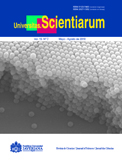Abstract
Objective. To describe morphologically and morphometrically the encephalon of Ariopsis seemanni. Materials and methods. We worked with 10 juvenile specimens which were processed according to the ethical standards for handling fish. Measurements of the total and standard length (cm) and weight (g) were taken for each individual. Specimens were fixed in 4% formaldehyde. The encephalon was removed, the different regions were identified and the measurement of the different lobes was done, indicating their location, morphology, length and area using lateral, dorsal and ventral digitalized images that were measured with the Scion Image program. We calculated means and standard deviations, and obtained the percentage equivalence of each structure in relation to the entire encephalon. These data were then related to the habits of the species. Results. We identified the olfactory bulbs, telencephalic hemispheres, optic lobes, cerebellum, among others. Of the cranial nerves, only the optic nerve was observed. The largest structure of the encephalon is the cerebellum (44 ± 1.2% and 0.23 ± 0.03 cm2 area), followed by the telencephalic hemispheres (28 ± 0.57% and 0.13 ± 0.02 cm2 area). Conclusions. The encephalon morphology of A. seemanni presented the general pattern of teleosts of the order Siluriformes, with the cerebellum as the largest structure of the encephalon. Based on the morphology and morphometry observed in the encephalon, we suggest that A. seemanni uses primarily vision and taste to explore the environment.
Key words: teleost, cerebral morphology, sensory sensitivity, neuroecolgy, Ariopsis seemanni.
Univ. Sci. is registered under a Creative Commons Attribution 4.0 International Public License. Thus, this work may be reproduced, distributed, and publicly shared in digital format, as long as the names of the authors and Pontificia Universidad Javeriana are acknowledged. Others are allowed to quote, adapt, transform, auto-archive, republish, and create based on this material, for any purpose (even commercial ones), provided the authorship is duly acknowledged, a link to the original work is provided, and it is specified if changes have been made. Pontificia Universidad Javeriana does not hold the rights of published works and the authors are solely responsible for the contents of their works; they keep the moral, intellectual, privacy, and publicity rights. Approving the intervention of the work (review, copy-editing, translation, layout) and the following outreach, are granted through an use license and not through an assignment of rights. This means the journal and Pontificia Universidad Javeriana cannot be held responsible for any ethical malpractice by the authors. As a consequence of the protection granted by the use license, the journal is not required to publish recantations or modify information already published, unless the errata stems from the editorial management process. Publishing contents in this journal does not generate royalties for contributors.



